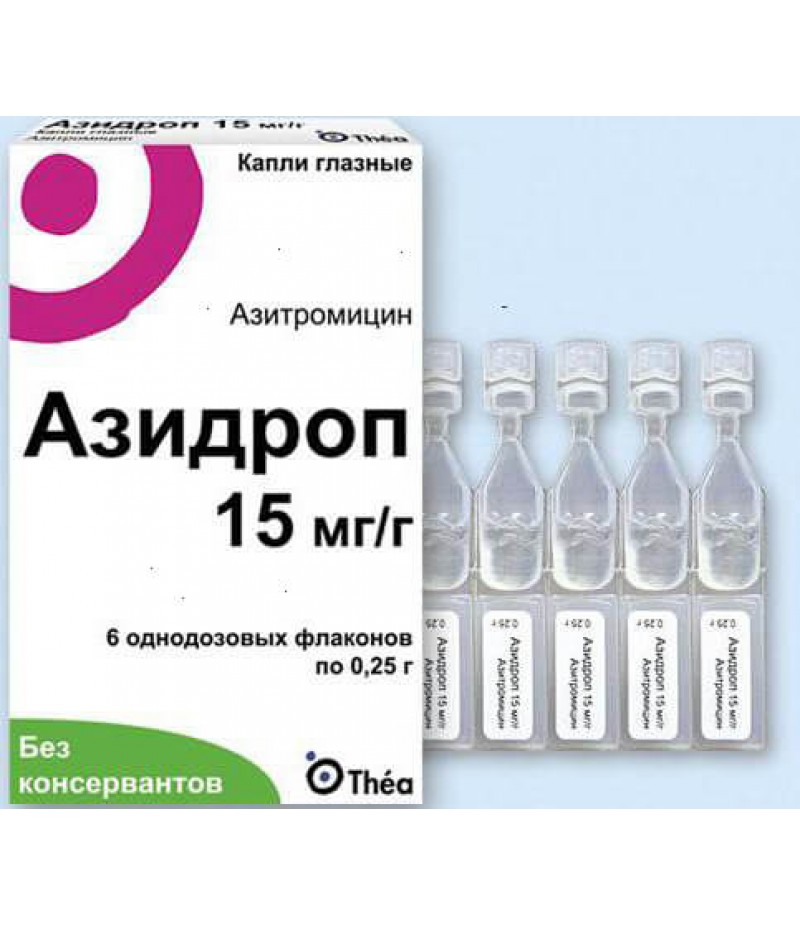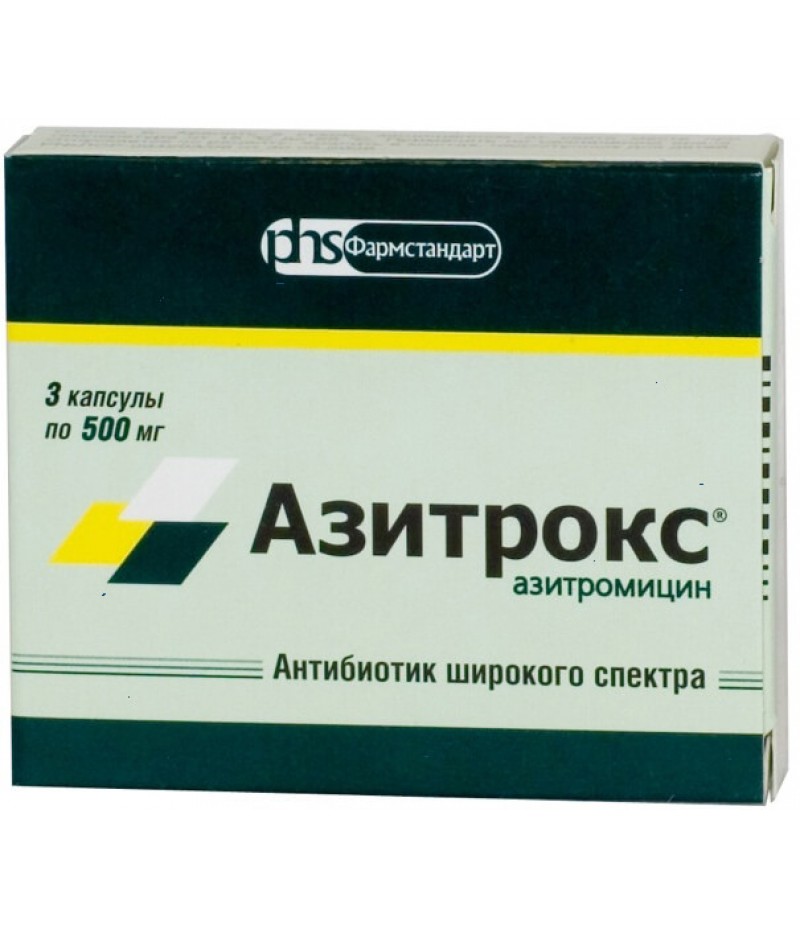Azidrop drops 15mg/gr 0.25gr #6
- $20.50
- 3 or more $20.25
- Availability:In Stock
Azidrop instruction for useYou can buy Azidrop eye drops on this pagepharmachologic effectAzithromycin is a broad-spectrum antibacterial agent belonging to the class of azalides, inhibits protein synthesis, binds to the 50S subuni..
Tags: drops
Azidrop instruction for use
You can buy Azidrop eye drops on this page
pharmachologic effect
Azithromycin is a broad-spectrum antibacterial agent belonging to the class of azalides, inhibits protein synthesis, binds to the 50S subunit of the ribosomes, slows the growth and multiplication of bacteria, and has a bactericidal effect at high concentrations. Effects on extracorporeal and intracellular pathogens. It is active against gram-positive microorganisms: Streptococcus spp. (groups C, F and G, other than those resistant to erythromycin), Streptococcus pneumoniae, Streptococcus pyogenes, Streptococcus agalactiae, Streptococcus group of viridans, Staphylococcus epidermidis, Staphylococcus aureus; Gram-negative bacteria: Haemophilus influenzae, Moraxella catarrhalis, Bordetella pertussis, Bordetella parapertussis, Legionella pneumophila, Haemophilus ducreyi, Campylobacter jejuni, Neisseria gonorrhoeae and Gardnerella vaginalis; Some anaerobic microorganisms: Prevotella bivia, Clostridium perfringens, Peptostreptococcus spp; as well as Chlamydia trachomatis, Chlamydia pneumoniae, Mycoplasma pneumoniae, Mycobacterium avium complex, Ureaplasma urealyticum, Treponema pallidum, Borrelia burgdorferi. Inactive against Gram-positive bacteria, resistant to erythromycin.
Pharmacokinetics
If the drug is used twice a day, a sufficient therapeutic concentration of azithromycin in the lacrimal fluid is provided. The half-life of the lacrimal fluid is about 12 hours. The concentration of azithromycin in the blood plasma after instillation of eye drops Azidrop at the recommended dose is less than the detection threshold (less than 0.0002 μg / ml).
Azidrop eye drops, indications for use
Treatment of conjunctivitis caused by drug-susceptible pathogens, incl. Chlamydia trachomatis, in adults and children from 1 year.
Contraindications
Individual hypersensitivity to azithromycin and other antibiotics of the macrolide group, as well as components of the preparation Azidrop; age less than 1 year.
Dosing and Administration
Locally.
Adults and teenagers (from 12 to 17 years), children (from 2 to 11 years)
Bury one drop in the conjunctival sac of the affected eye twice a day (morning and evening) for three days.
If there is no positive dynamics within 3 days of the drug, you should consult your doctor and review the treatment.
Children (from 1 year to 2 years)
In the treatment of trachomatous conjunctivitis, dose adjustments are not required.
There is no sufficient experience in the treatment of purulent bacterial conjunctivitis with the use of eye drops Azidrop in children younger than 2 years.
Children up to one year old
There is insufficient experience in the treatment of trachomatous conjunctivitis and purulent bacterial conjunctivitis with the use of eye drops Azidrop in children under the age of one year.
The elderly
Older patients are not required to adjust dose.
Patients should follow the following guidelines:
it is necessary to wash hands thoroughly before dropping in drops and after the procedure;
Do not touch the eye and eyelids with the tip of the dropper;
After a single use, the tube-dropper must be discarded along with the remaining residue. Do not use the remaining solution in a dropper for the next instillation.
Application in pregnancy and lactation
Since systemic exposure to azithromycin is negligible, no harmful effect of the drug is expected during pregnancy.
Possible use of the drug Azidrop, eye drops, for the treatment of pregnant women as prescribed by the attending physician, if the expected therapeutic effect for the mother exceeds the risk of developing possible side effects in the fetus.
There is limited evidence that azithromycin is excreted in breast milk, but given the low doses and low systemic availability, the impact on the newborn is very low. Thus, treatment with the use of the drug Azidrop during breastfeeding is acceptable.
Side effects
Side effects noted during the studies of the drug Azidrop, eye drops, are systematized according to the classification of the World Health Organization (WHO) by the frequency of occurrence: very often (more than 1/10); often (more than 1/100, less than 1/10); infrequently (more than 1/1000, less than 1/100), rarely (more than 1/10000, less than 1/1000) and very rarely (less than 1/10000).
Impaired immune system: very rarely - hypersensitivity, angioedema (Quincke's edema).
Disorders from the eyes: very often - eye discomfort (itching, burning, tingling) after instillation of the drug; often - blurred vision, a feeling of coalescence of the eyelids, a foreign body in the eye; infrequently - lacrimation; very rarely - eczema, erythema, eyelid edema, eye allergy, conjunctival hyperemia, allergic conjunctivitis, conjunctivitis, keratitis.
special instructions
Eye drops should not be injected or swallowed.
Eye drops can not be administered as peri- and intraocular injections.
In case of an allergic reaction to the drug, treatment should be discontinued.
In the case of concomitant treatment with other ophthalmic drugs, the drug Azidrop should be instilled last, 15 minutes after the installation of another drug.
According to the current international recommendations for the treatment of eye and genitourinary diseases, which can be transmitted to newborns with high probability, non-peptic conjunctivitis caused by Chlamydia trachomatis and conjunctivitis caused by Neisseria gonorrhoeae require systemic treatment.
Except for the treatment of trachomatous conjunctivitis, eye drops Azidrope is not recommended for use in children younger than 2 years of age, since there is insufficient clinical information about the therapy in this age group.
This type of treatment is not intended for use as a prophylaxis of bacterial conjunctivitis in newborns.
The patient should be informed that there is no need to continue burying eye drops after the completion of therapy on the third day, even if the residual signs of bacterial conjunctivitis are still present. Patients suffering from bacterial conjunctivitis should not wear contact lenses.
Against the background of systemic use of azithromycin, there have been reports of the development of lightning-fast hepatitis, which can potentially lead to life-threatening liver failure. When using the drug in ophthalmology, such a risk does not exist, since the systemic effect of the active substance is extremely low.
Impact on the ability to drive vehicles and manage mechanisms
Patients who, after the application of eye drops, have a transient fogging of vision, it is not recommended to drive vehicles or work with mechanisms until vision is restored.
Azidrop Interactions
Studies of the interaction of the drug Azidrop with all specific drugs have not been conducted.
In connection with the absence of detectable concentrations of azithromycin in blood plasma when dropping the eye drops of Azidrop (see Pharmacokinetics section), no interaction with any of those drugs that interact with azithromycin upon oral administration is expected.
Overdose
Information on cases of overdose is absent.
In a disposable package, azithromycin is contained in an amount sufficient to treat both eyes, but insufficient to cause adverse reactions after accidental intravenous administration or ingestion of the solution.
Storage conditions
Store at a temperature not exceeding 25 ° C. Keep out of the reach of children.
Shelf life - 18 months
Terms of sell
To buy Azidrop the prescription is not required.


